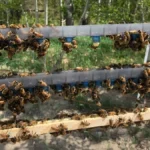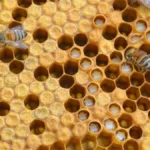Do queen bees fly? Yes! But the answer is more interesting than that – let us have a look at why and how queen bees fly. Queen bees are fascinating creatures – let us take a quick adventure and look at these empowered ladies and how they work.
Do Queen Bees Fly?
A queen bee and a worker bee are quite similar. Both are female and are genetically very similar. A queen has the ability to develop big ovaries which can lay fertilized or unfertilized eggs. A worker can develop small ovaries and does not have the ability to lay both fertilized and unfertilized eggs.
Queens are bigger than workers, and also have more propulsive efficiency in their wings. In the beehive, there are three types of bees – workers (female), drones (male), and a queen (female). Of these three types of bees, the queen is able to fly the fastest. We will have a look at why this is important shortly.
Ok, we have now established that queen bees fly, but let us ask the more important question…
Why Do Queen Bees Fly?
Queen bees leave the hive for the first time to conduct mating flights. Once a queen is mated, the most common reason she will leave the hive is when the hive swarms. Queens are quite odd creatures.
Read more about: Do Queen Bees Leave The Hive?
I have in the past once or twice seen a queen just take midnight wanders out of the hive – you will with time see this. Sometimes she just walks out onto the landing board of the hive, has a little leg stretch, makes a buzz, and goes back inside. It is probably nice to get some fresh air if you have to lay 2000 eggs a day and live in a box with 60 000 of your kids licking you all the time.
The Queen Bee Mating Flight
A virgin queen emerges from her cell and will quickly go around the hive and try to sting any other queen cells to death. A queen bee is an incredible animal. When workers and drones emerge from the brood stage they are a bit soft and grey and very slow-moving.
New workers and drones take a day or so to harden up and get their act together. A queen bee emerges in full fight and flight mode – she will shoot out of the queen cell like a rocket and immediately head off on a seak and destroy rampage through the hive to kill any other queen she can find.
Once our new virgin queen has established her dominance in the hive, she will prepare for her mating flight. Sometimes she will go out a few times on orientation and exercise flights just to figure out the finer details of navigation and being fit.
The Drone Congregation Area
On the day of the mating flights, she will leave the hive and fly to an area known as a drone congregation area or DCA. These areas are regions where drones go and hang out hoping to get lucky. Imagine them a bit like a singles bar – with a hell of a lot of guys and very few girls.
If you imagine a DCA in an area where you have 200 hives, and each hive has a population of 800 drones to contribute, then that DCA could have around 160 000 drones buzzing around. If you find yourself walking on a windless warm day, and you are in a meadow surrounded by trees on the edge, you will often find the DCA will be high above this area. You can hear the hum.
I used to live next to a field that was a DCA (I had 50-100 hives in my backyard at any time so that was no surprise). On a warm day in spring, it was great fun to watch drone comets. Let us look at what these are.
Learn more about: Drone Brood vs Worker Brood
A drone bee top compared to the worker bee. Note the size of the drone in comparison to the worker.
The Drone Comet
The drone comet is a cloud of drones that follow the queen. As she enters the DCA she will emit a mating pheromone and every boy (drone) will pick up on this faster than guys swiping right on a girl who says she wants an NSA hookup now. The queen knows her game, however, and she wants the best drones.
She will fly around staying just ahead of the ever-increasing number of drones who are chasing her – the idea here is to tire them out. The drones who are the strongest, and most efficient in flying will be at the front of the comet, and the weaker guys lag behind and get tired. She will then slow down and mate in the air with a selection of the best drones.
How Many Drones Does A Queen Mate With On The Queen Bee Mating Flight?
Well, she was a virgin to start with but unlike most humans, the magical “three number” is not the case for total matings. Typically a queen bee will mate with between 15 and 30 drones (upper limit 60) depending on the area and race of the bee.
Why Do Virgin Queens Mate With Drones In The Air?
This follows on from what we spoke about earlier – a queen wants to test her boys out for their strength and speed. When a drone mates with her, he grabs her and inserts his endophallus – a drone is very very well endowed as a percentage of his body – and then he sort of falls apart. The queen will fly away and rip his manhood off harvesting his sperm and he falls away, spent, and dies soon afterward.
The next drone will then catch the queen, remove the previous drone’s endophallus and have his way, sharing a similar fate to the previous gent. So the process continues until the queen has had enough for the day, or enough for her life. Sometimes a queen will perform a few mating flights, sometimes just one. I guess each queen has her own ideas about what she needs in life.

The drone’s endophallus is visible here. It is a somewhat disturbing-looking thing.
How Do The Matings Affect The Hive?
The genetics of different drone fathers confer different abilities upon the offspring. Worker bees are hatched from fertilized eggs. Half of the DNA in a worker is from the queen and half from her drone father.
Queens are diploid – meaning they have two sets of chromosomes – so they can produce eggs that are haploid (one set of chromosomes). The drones are haploid, so their sperm are haploid – one set of chromosomes. The maths is hence two types of eggs x number of drones equals workforce diversity. This means a hive can have 20-120 genetic lines of workers based on the mother and father combinations. This is a diverse workforce.
Do Queen Bees Leave The Hive To Die?
No. Well not intentionally. I once saw a queen leave a hive and fly straight into a predatory bird’s mouth. Disaster. Generally, a queen bee will live in the hive laying eggs until she runs low on stored sperm and gets superseded.
She will also swarm a few times in her life and found new hives. When she gets old, she will either get killed by a young queen, or she will just die. I have seen a queen die – they just sort of stop, shiver a bit, and fall to the bottom of the hive. The workers will ball around her for a day or so, and then rather unceremoniously carry her out and dump her in the bushes a few hundred yards from the hive. Bees are not sentimental.
In summary: Do queen bees fly – yes! Very well, very fast, and they have a lot of fun the first few times!! If you enjoyed this, please share.
Queen Bee Flight FAQs
Do queen bees fly?
Yes, queen bees do fly, but only under specific circumstances. They primarily fly during their mating flights or when swarming. Virgin queens also take orientation flights to familiarize themselves with their surroundings.
Why do queen bees fly?
Queen bees fly for mating purposes and to establish dominance by leaving the hive during swarming events. A virgin queen also flies to mate with drones in the air, securing her role as the reproductive leader of the hive.
What is a queen bee mating flight?
A queen bee mating flight is when a virgin queen leaves the hive to mate with multiple drones in midair. These flights typically take place in warm weather, ensuring genetic diversity in the hive through multiple matings.
How many drones does a queen bee mate with?
A queen typically mates with 15-30 drones during her mating flights. This genetic diversity ensures that her hive will have a mix of strong and efficient worker bees.
What is a Drone Congregation Area (DCA)?
A Drone Congregation Area (DCA) is a specific location where drones gather in large numbers to mate with queens. Queens seek out these areas during mating flights, where the strongest drones will successfully mate with her.
What happens during a drone comet?
A drone comet forms when a queen enters a DCA and emits pheromones, attracting drones. The drones chase the queen, and only the fittest ones manage to mate with her, ensuring the strongest genetics are passed on.
Why do drones die after mating?
After mating with the queen, a drone’s reproductive organ is torn from its body, causing fatal injuries. This sacrifice allows the queen to collect and store sperm for her lifetime of egg-laying.
Do queen bees leave the hive after mating?
Once a queen completes her mating flights, she typically stays in the hive for the rest of her life, unless she leaves during swarming. Swarming happens when the colony becomes too large, and the queen leads part of the colony to a new location.
Do queen bees fly for exercise?
Virgin queens sometimes take orientation and exercise flights before their mating flight. These flights help the queen get accustomed to flying and prepare her for the longer journey of mating.
Do queen bees leave the hive to die?
Queens do not intentionally leave the hive to die. They are typically replaced when they can no longer reproduce effectively, either through natural death or being superseded by a younger queen. If a queen is old or injured, worker bees may carry her out of the hive.

Dr. Garth A. Cambray is a Canadian/South African entrepreneur and beekeeper with 28 years of experience in apiculture and specializes in adding value to honey. His Ph.D. research developed a new advanced continuous fermentation method for making mead that has resulted in a number of companies globally being able to access markets for mead. His company, Makana Meadery, exports honey mead to the USA where it is available to discerning connoisseurs. He has also developed technologies to commercially manufacture organic honey vinegar in Zambia for export globally. He holds a few patents globally in the ethanol industry and believes in technology and knowledge transfer for human development and environmental sustainability. One of his proudest achievements is the fact that the wind farm he started at one of his old apiary sites has essentially made his hometown carbon neutral.







